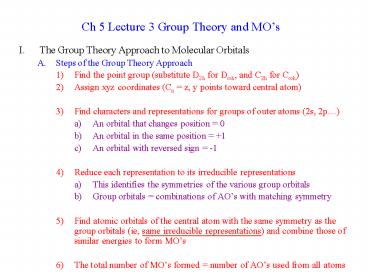Ch 5 Lecture 3 Group Theory and MOs - PowerPoint PPT Presentation
1 / 14
Title:
Ch 5 Lecture 3 Group Theory and MOs
Description:
Ch 5 Lecture 3 Group Theory and MO's. The Group ... Homonuclear diatomic molecules (nonpolar) H2 Ne2. Heteronuclear diatomic molecules (polar) C O, LiF-ionic ... – PowerPoint PPT presentation
Number of Views:132
Avg rating:3.0/5.0
Title: Ch 5 Lecture 3 Group Theory and MOs
1
Ch 5 Lecture 3 Group Theory and MOs
- The Group Theory Approach to Molecular Orbitals
- Steps of the Group Theory Approach
- Find the point group (substitute D2h for D8h, and
C2h for C8h) - Assign xyz coordinates (Cn z, y points toward
central atom) - Find characters and representations for groups of
outer atoms (2s, 2p) - An orbital that changes position 0
- An orbital in the same position 1
- An orbital with reversed sign -1
- Reduce each representation to its irreducible
representations - This identifies the symmetries of the various
group orbitals - Group orbitals combinations of AOs with
matching symmetry - Find atomic orbitals of the central atom with the
same symmetry as the group orbitals (ie, same
irreducible representations) and combine those of
similar energies to form MOs - The total number of MOs formed number of AOs
used from all atoms
2
- H2O
- Water is in the C2v point group
- The C2 axis z-axis xz plane is the plane of
the molecule - Since the molecule is planar, we dont need to
assign axes to Hs - H(1s) orbitals have no directionality
- Use the H(1s) orbitals to find the reducible
representation - Use the reduction formula to identify the
irreducible representations - A1 caH(1s)a cb(H1s)b
- B1 caH(1s)a - cb(H1s)b
3
- Find O AOs with the same symmetry
- a) 1s, 2s orbitals are of A1 symmetry (s is
always most symmetric) - b) 2pz orbital is of A1 symmetry (use z in
character table) - c) 2px orbital is of B1 symmetry (use x in
character table)
4
- There are 6 total MOs
- The A1 group O(2s) O(pz)
- Y1 Bonding
- Y3 Nonbonding
- Y5 Antibonding
- b. The B1 group O(px)
- Y2 Bonding
- Y6 Antibonding
- The oxygen py Y4
- 8 valence electrons fill Y1-Y4
- BO 2
- Lone pair 2
- Compare to Lewis Structure
- 1 lone pair nonbonding HOMO (2py)
- 1 lone pair LOMO (Y3 2s)
- 2 bonding pairs in the middle
- All four orbitals are different
5
- NH3
- Ammonia is in C3v point group
- C3 axis is assigned as the z-axis, the yz plane
passes through N and one H - Use character table to find irreducible
representations - Identify orbital and group orbital symmetries
- A1 Ha Hb Hc
- E Hb Hc
- 2Ha Hb Hc
- A1 s, pz
- E px, py
6
Ha
A1
Hb
Hc
NH3, there are 3 hydrogen atoms. ? 3 1s orbitals
2Ha
Hb
Hc
E
Hc
Hc
7
Bonding molecular orbitals
A1
s
py
E
px
8
- Combine Orbitals to give 7 MOs
- A1 group 2s 2pz a1
- Bonding 2a1
- Antibonding 4a1
- Nonbonding 3a1
- E group 2px 2py e
- 2 bonding (degenerate) 1e
- 2 antibonding (degenerate) 2e
- Put in 8 valence electrons
- BO 3 (2a1, 1e)
- Lone pair 3a1
9
- D. BF3 (Lewis Acid)
- Point Group D3h
- C3 axis z-axis, F y-axis points to B, F x-axis
is in the plane of the molecule - Find Reducible, Irreducible Representations
- Find suitable orbitals
10
- Results
- BF should have some double bond character
- 4a1, 3e are bonding BO 3
- 1a2 is somewhat bonding too
- The LUMO is an empty p orbital
- 2a2 is LUMO
- Lewis acidity explained
- More complex molecules by computer program
11
- Hybrid Orbitals
- Utility
- Developed in Valence Bond Theory
- Not needed anymore, but emphasizes symmetry
- Hybrid Orbitals
- Orbitals on a central atom can be combined 1s
3p orbitals 4sp3 orbitals - Equivalent, directional orbitals result
- Methane
- Reducible representation found from what happens
to four vectors - Irreducible representations found as usual
- A1 2s, T2 px, py, pz (or dxy, dxz, dyz) sp3
hybrid orbitals - Example Find hybridization and orbital involved
for BF3
12
(No Transcript)
13
Molecules we learn
- Homonuclear diatomic molecules (nonpolar)
- H2 ? Ne2
- Heteronuclear diatomic molecules (polar)
- C?O, LiF-ionic
- Linear large molecules (group orbitals group
theory approach) - FHF- (central atom ? s orbital only)
- OCO (central atom ? s, p orbitals)
- Non-linear large molecules (group orbitals
group theory approach) - H2O (outer atoms ? s orbital only)
- NH3 (outer atoms ? s orbital only)
- BF3 (the most difficult) (outer atoms ? s,p
orbital only)
14
We need
- Able to draw molecular orbital diagrams of all
these molecules. - Energy level MO sketch
- Bond order prediction































